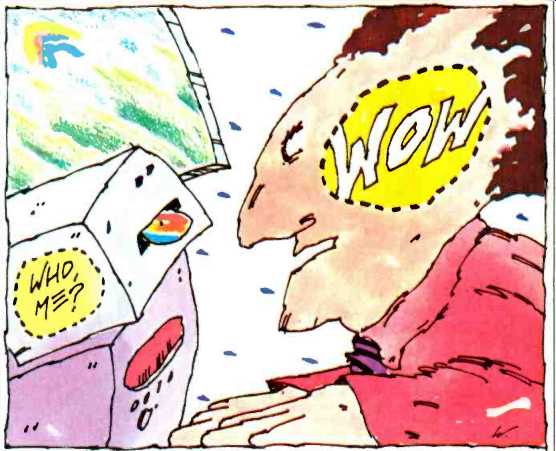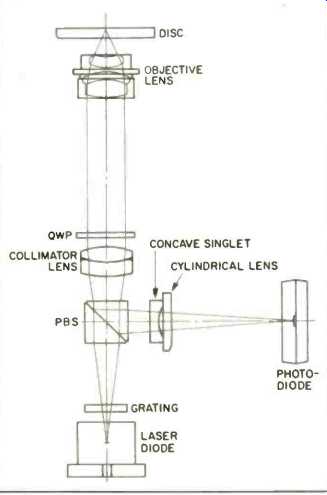OPTIMUM OPTICS

The Compact Disc system impresses the heck out of me. I've been fooling around with digital audio for 10 years, listening critically to recorded music for 15 years, and I've never heard it this well. I dismiss most of the claims against the CD as being space-cadet musings of quacks or nefarious alarms of people with heavy investments in analog. It is a full-fidelity system better able to preserve and reproduce music than any other con sumer system. As a musician, I am fully sold on its musicality in every respect--from expression of nuance to undistorted fortissimos. But my admiration doesn't stop there; as a computer systems designer, I am filled with admiration for the system's engineering excellence.
Good engineering doesn't mean complexity or impenetrability of design intent-far from it. A suspension bridge gracefully spanning a canyon or an elegantly conceived computer CPU card each illustrate good engineering.
A good design is essentially simple almost purposefully sparse to make the product reliable and affordable. In my mind the Compact Disc system exemplifies this. Very tricky obstacles have been overcome through high technology to achieve the kind of elegant solution that looks obvious once you've seen it done. Perhaps the best example of this lies in the optical technique used for the discs and the players. For the next several months I would like to explore the design of the optical pickup, its automatic tracking and automatic focus systems, as well as the nature of the optical track on the discs themselves.
Let there be no mistake: The Compact Disc system is a remarkable engineering accomplishment. The high density storage and contactless data reading make it one of the most advanced storage mediums available.
One of the secrets of this system is the optical pickup used to read the data from the disc. A disc might contain 10 billion pits precisely arranged on a spiral track; the optical pickup must focus, track, and read that data track.
The entire lens structure, a combination of the laser source and the reader, must be small enough to glide laterally beneath the disc, moving in response to tracking information and user random-access programming. Engineers have solved these pickup design criteria admirably; the CD pickup shown in Fig. 1 is a beautifully conceived piece of work. Although design particulars vary among manufacturers, they are generally very similar.
A conventional gas laser would be too bulky for use as a pickup; instead, the CD pickup uses a semiconductor laser with a 5-mW optical output irradiating a coherent-phase laser beam with a 780-nm wavelength. The light emitting properties of semiconductors have been utilized for many years; for example, light-emitting diodes (LEDs) use this mechanism to emit ordinary light. However, laser light is significantly different from ordinary light since it is coherent in phase. Because the initial level of the light is low, several amplification steps are needed to raise the output. This is done by adding forward bias to a PN transistor junction and then recombining the emitted light. The recombining requires a modified semiconductor, one which has a "carrier" inserted in the activating layer, which is made of AlGaAs (aluminum, gallium, and arsenic). The activating layer is sandwiched between layers of material which have refraction ratios which are different at both boundaries, and the crystal surface towards the emitted light is made reflective. The result is a light resonator with constant wave emission.
A monitor photodiode is placed next to the laser diode to control power to the laser to compensate for temperature changes. The monitor diode conducts current in proportion to the laser's light output.
For tracking and reading, the light from the laser point source (in most players) passes through a diffraction grating, which is a screen with slits spaced only a few laser wavelengths apart. As the beam passes through the grating, it diffracts at different angles; when the resulting collection is again focused, it will appear as a single, bright, centered beam with a series of successively less intense beams on either side. The pickup system uses the center beam for reading data, tracking, and focusing, and the two first order beams only for tracking.
The next part of the optical system, a polarization beam splitter (PBS), directs the laser light to the disc surface, then angles the reflected light to the photo sensor. The PBS consists of two prisms with a common 45° face, separated by a membrane. That membrane acts as a one-way mirror; the coherent, polarized light from the laser passes through it to the disc surface, while the light returning from the disc, which has the opposite polarization, is reflected and angled toward the side of the prism facing the photo sensor which eventually reads the digital data.
A collimator follows the PBS (in some designs, it precedes it). Its purpose is to make the divergent light rays parallel. The light then passes through a quarter-wavelength plate (QWP), a special crystal material which controls the polarization of the light beams to make the PBS work. The light's phase is shifted 90° each time it passes through the QWP, once en route to the disc and again on its return. The reflected light is thus 180° out of phase relative to the incoming light at the beam splitter, so the PBS will properly deflect it.

Fig. 1--A typical CD-player optical system.
The final piece of optics in the path to the disc is the objective lens; it is used to focus the beams on the disc surface. The main spot is about 0.8 mm in diameter on the outer surface of the transparent polycarbonate layer.
The refractive index of the polycarbonate layer is 1.55 and its thickness is about 1.2 mm, so the spot is narrowed to 1.7 micrometers at the reflective surface, slightly wider than the pit width of 0.5 micrometer. The objective lens is attached to a two-axis actuator and servo system which moves it up and down for focusing and laterally for tracking.
The data encoded on the disc now determines the fate of the laser light.
When the spot strikes an interval between two pits, the light is almost totally reflected; when it strikes a pit, one with a depth in the transparent layer of about a quarter wavelength of the laser light, interference causes less light to be reflected. (Though the spots encoding the data are commonly called pits, because they're pressed into the disc's upper surface, they are actually bumps as seen by the laser, which reads them from below.
The varying-intensity light beams return through the objective lens, the QWP (for their second 90° phase shift), and the collimator lens to strike the angled surface inside the PBS. There, they are deflected 90° and pass through a singlet lens and a cylindrical lens en route to the photodiode.
The cylindrical lens is part of the focusing servo system. As the disc surface deviates (as much as ± 0.6 mm), the laser image passing through the cylindrical lens changes shape from round (if the disc is in focus) to elliptical (if it's out of focus). A four-quadrant photodiode senses this and sends that information to the servo system, to keep the objective lens focused at the proper depth of ±2 µm.
The center beam, which carries the data from the disc and controls auto focusing, has been accompanied by the two secondary beams since the diffraction grating. The tracking beams also struck the disc surface and were reflected, and their varying intensity is now used at two separate photodiodes mounted alongside the four-quadrant photodiode. When the central beam is properly tracking the pit track, their intensity is equal. The tracking beams have unequal intensity when the central beam has deviated. Then, a servo system uses the output of the tracking photodiodes to bring the beam back on track. Both auto-focus and auto tracking involve clever ideas; we'll cover them in later columns.
The Compact Disc pickup is thus a fairly simple device after all--nothing that a sharp high-school physics major couldn't have dreamed up. The resulting simplicity breeds reductions in cost and size. Pickups now account for about one-third the cost of the total player, but that will fall fast, especially as volume of production increases.
New pickups less than 2 cm high now permit car and portable CD players. In the CD pickup, engineers have come up with an elegant design. And that, as I have noted, is the mark of outstanding engineering: When a complicated problem is solved-compactly.
(adapted from Audio magazine, Jan. 1985; KEN POHLMANN )
= = = =